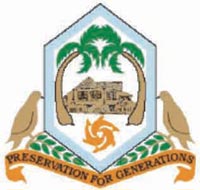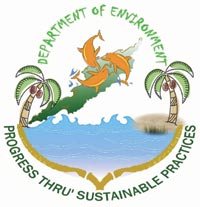Biodiversity is Our Business –
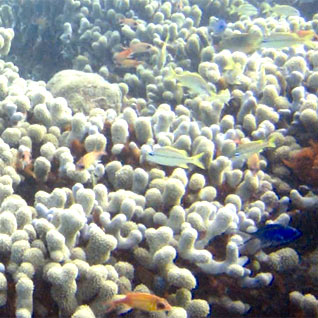 |
| Large finger coral (Porites
porites) colony in Anguilla (photo by S. Wynne) |
With 70 percent of the Earth’s surface covered by water, the
underwater world is as vast as it is unexplored. Compared to the
land-based world, we know very little about this aquatic environment
(and we actually don’t know all that much about the above-water part of
the planet either…). We do know, though, that there are at least 34
major phyla – the second largest unit of biological classification –
within the seas and oceans and 16 of these 34 are exclusively marine. In
comparison, only one phylum is solely and entirely land-based.
A recent report released by scientists trying to document every marine
life form on the planet states that already 120 000 species have so far
been recorded and that number is actually expected to more than double
to 250 000 by 2010. It is believed, though, that total coastal and
marine species numbers could actually range between 500 000 and 10
million. Of course, these figures are global and represent species that
live in shallow tidal lagoons all the way the deep sea hot vents.
Despite this, coastal areas still remain vibrant and diverse in
underwater life. Coral reefs, in particular, provide habitat to about 25
percent of all identified marine species. This is especially impressive
since coral reefs cover less than 0.1 percent of the Earth’s seas and
oceans.
Existing within critical ecological relationships, coral reefs, seagrass
beds, and mangrove forests work together to perform essential services
that support human life. Even on small Anguilla – or perhaps more so
because of being on Anguilla – we can’t ignore the importance of coastal
and marine ecosystems.
An intricate network of coral reefs and seagrass beds, along with the
island’s limited but important mangrove forests, help to maintain a
delicate balance that keeps Anguilla’s coastal waters and shoreline
clean, stocked with fish, lined with white sand, and protected from
excessive and destructive wave action.
Let’s take a closer look at why we need to conserve Anguilla’s coastal
and marine ecosystems.
- About 700 people in Anguilla – about 5 percent of the population
– are involved in the island’s fishing industry. The fishing sector
contributes approximately 2.5 percent annually to the island’s gross
domestic product and fish catches provide an important source of
protein to many Anguillians. Many of the fish caught by Anguillian
fishers – both recreationally and for commercial sale – are found in
coastal and reef waters, including jacks, snappers, groupers,
parrotfish, doctorfish, and old wife. Many of these fish species,
including a multitude of others, spend at least part of their lives
in the protective nursery and feeding grounds of Anguilla’s seagrass
beds and, to a more limited extent, its mangrove forests.
- Along with species of fish that are harvested are those species
that are intricately linked to them – brain, star, and branching
corals; sea fans and sea whips; sponges, worms, and molluscs, sea
urchins, sea stars, and sea turtles; lobsters, crayfish, and rays;
crabs, octopus, jellyfish, and crabs. And this is only a drop in the
hat.
- In Anguilla, at least 31 species of fish are targeted and
harvested along with 2 species of lobster and 1 species of conch.
There are 4 species of mangroves, 1 major species of seagrass, and
at least 30 species of stony, reef-building corals. There are at
least 20 different types of sponges – and this number may represent
only a small percentage of what is actually in Anguilla’s waters.
- Anguilla’s marine and coastal species and the relationships that
exist among them and the physical environment in which they live
create ecological services. These services include: providing food,
water, timber, medicine, and construction material; regulating the
climate by storing and releasing carbon dioxide; cleaning the water
by filtering sediment and nutrients; acting as a barrier
(particularly coral reefs) against ground seas and strong wave
action caused by storms and hurricanes; providing opportunities for
recreation (swimming, snorkelling, SCUBA diving, and sport fishing);
assisting with soil formation, photosynthesis, and nutrient cycling;
and providing spiritual and cultural benefits that are tied to
Anguilla’s marine traditions – including boat racing and whelk
harvesting.
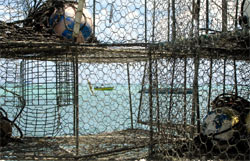 |
| Fish pots on the Island
Harbour wharf (photo by F. Mukhida) |
- Anguilla’s coastal and marine biodiversity is considered to be
the island’s most important natural asset with its total value to
Anguilla being estimated at almost EC$7 million per year.
- But marine and coastal biodiversity is under threat: habitats
are being destroyed to make way for buildings; water is being
polluted by sewage seepage and dumping, sand is being mined, bays
are being dredged, anchors are being dropped on corals; reefs and
seagrass beds are being suffocated by excessive algal growth and
sediment from land and beach erosion; fish stocks and other marine
organisms are being over-exploited; and the health of the island all
of its inhabitants are being compromised.
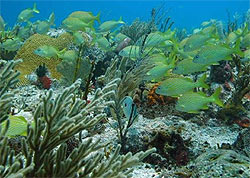 |
| Anguilla’s coral reefs
support a diversity species that range from small invertebrates,
to fish, to sea turtles (photo by S. Donahue) |
In the 2008 National Biodiversity Strategy and Action Plan (NBSAP)
for Biodiversity Conservation in the Fisheries, Marine, and Coastal
Sector of Anguilla, one of its key findings was the need to increase the
level of awareness of the importance, value, and need to effectively
protect marine and coastal habitats. The Department of Fisheries and
Marine Resources (DFMR) has also recognised the need for data and
research to support and inform management decisions as well as
educational materials. To that end, the DFMR has been compiling an
underwater guide to Anguilla which should be ready for publication in
2009. As a comprehensive guide, it includes species that exist in all of
Anguilla’s coastal and marine habitats – ranging from the nearshore
seagrass beds, to the colourful coral reefs, to the open ocean, to the
surprisingly diverse underwater sandy sea bottom stretches.
In addition, the NBSAP makes key recommendations for marine and
coastal biodiversity conservation that include:
- Enhancing the capacity of the DFMR and supporting agencies to
manage coastal and marine resources;
- Developing and implementing relevant legislation and
regulation;
- Developing and implementing relevant policies and programmes at
the Departmental level;
- Increasing levels of awareness about the coastal and marine
biodiversity conservation and values; and
- Coordinating an integrated approach to coastal and marine
biodiversity conservation.
Anguilla’s underwater world is a beautiful, fluid, and dynamic place
that is essential to the economic, social, and cultural
 |
| Green sea turtles are
endangered species (photo by S. Donahue) |
well-being of
island. The diversity and complexity of that environment sometimes makes
it easy for us to underestimate (and difficult for us to understand) the
impacts that we have on it – whether it be through coastal development,
direct habitat destruction and degradation, or over-harvesting. But that
diversity and complexity make it all that much more pressing that we try
to manage and minimise the impact of our own activities on an
environment on which we are so dependent.
Information for this article was sourced from: Amoy Lum Kong’s Report on
the Anguilla Fisheries/Marine/Coastal Sector (2008); the Encyclopedia of
Earth’s Marine Ecosystem Services (2006); the CBC News’ article
Scientists uncover more marine species, clues to octopus origins (2008);
and GESAMP’s A Sea of Troubles (2001).
Funding for this article was provided by the Overseas Territories
Environment Programme through the Department of Environment (Government
of Anguilla).
|




